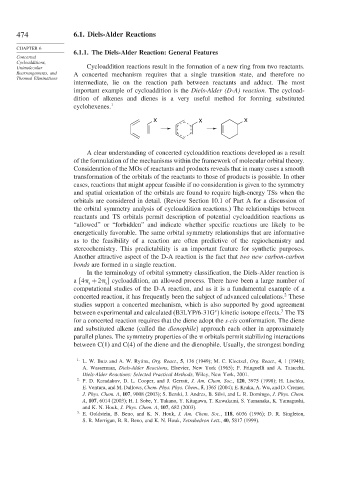Page 500 - Advanced Organic Chemistry Part B - Reactions & Synthesis
P. 500
474 6.1. Diels-Alder Reactions
CHAPTER 6
6.1.1. The Diels-Alder Reaction: General Features
Concerted
Cycloadditions,
Unimolecular Cycloaddition reactions result in the formation of a new ring from two reactants.
Rearrangements, and A concerted mechanism requires that a single transition state, and therefore no
Thermal Eliminations
intermediate, lie on the reaction path between reactants and adduct. The most
important example of cycloaddition is the Diels-Alder (D-A) reaction. The cycload-
dition of alkenes and dienes is a very useful method for forming substituted
cyclohexenes. 1
X X X
A clear understanding of concerted cycloaddition reactions developed as a result
of the formulation of the mechanisms within the framework of molecular orbital theory.
Consideration of the MOs of reactants and products reveals that in many cases a smooth
transformation of the orbitals of the reactants to those of products is possible. In other
cases, reactions that might appear feasible if no consideration is given to the symmetry
and spatial orientation of the orbitals are found to require high-energy TSs when the
orbitals are considered in detail. (Review Section 10.1 of Part A for a discussion of
the orbital symmetry analysis of cycloaddition reactions.) The relationships between
reactants and TS orbitals permit description of potential cycloaddition reactions as
“allowed” or “forbidden” and indicate whether specific reactions are likely to be
energetically favorable. The same orbital symmetry relationships that are informative
as to the feasibility of a reaction are often predictive of the regiochemistry and
stereochemistry. This predictability is an important feature for synthetic purposes.
Another attractive aspect of the D-A reaction is the fact that two new carbon-carbon
bonds are formed in a single reaction.
In the terminology of orbital symmetry classification, the Diels-Alder reaction is
a 4 + 2 cycloaddition, an allowed process. There have been a large number of
s
s
computational studies of the D-A reaction, and as it is a fundamental example of a
2
concerted reaction, it has frequently been the subject of advanced calculations. These
studies support a concerted mechanism, which is also supported by good agreement
3
between experimental and calculated (B3LYP/6-31G ) kinetic isotope effects. The TS
∗
for a concerted reaction requires that the diene adopt the s-cis conformation. The diene
and substituted alkene (called the dienophile) approach each other in approximately
parallel planes. The symmetry properties of the orbitals permit stabilizing interactions
between C(1) and C(4) of the diene and the dienophile. Usually, the strongest bonding
1
L. W. Butz and A. W. Rytina, Org. React., 5, 136 (1949); M. C. Kloetzel, Org. React., 4, 1 (1948);
A. Wasserman, Diels-Alder Reactions, Elsevier, New York (1965); F. Fringuelli and A. Tatacchi,
Diels-Alder Reactions: Selected Practical Methods, Wiley, New York, 2001.
2 P. D. Karadakov, D. L. Cooper, and J. Gerratt, J. Am. Chem. Soc., 120, 3975 (1998); H. Lischka,
E. Ventura, and M. Dallows, Chem. Phys. Phys. Chem., 5, 1365 (2004); E. Kraka, A. Wu, and D. Cremer,
J. Phys. Chem. A, 107, 9008 (2003); S. Berski, J. Andres, B. Silvi, and L. R. Domingo, J. Phys. Chem.
A, 107, 6014 (2003); H. I. Sobe, Y. Takano, Y. Kitagawa, T. Kawakami, S. Yamanaka, K. Yamagushi,
and K. N. Houk, J. Phys. Chem. A, 107, 682 (2003).
3
E. Goldstein, B. Beno, and K. N. Houk, J. Am. Chem. Soc., 118, 6036 (1996); D. R. Singleton,
S. R. Merrigan, B. R. Beno, and K. N. Houk, Tetrahedron Lett., 40, 5817 (1999).

